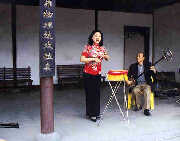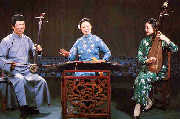|

|
|
Fujian Nanyin
|
Dagu Lyrics
 |
|
Xihe Dagu
|
It is also called guci or dagushu which is mainly popular in northern China. Dagu has a long history and is somewhat influenced by guzici of Song Dynasty. The performers beat the drum while singing. The main accompanimentmusical instrumentsare sanxian, sihu,pipa, dulcimer. Genres of dagu are many such as muban dagu, jingyun dagu,Xihe dagu,Leting dagu,meihua dagu, tiepian dagu, jingdong dagu, dongbei dagu, Lu' an dagu, Xiangyuan dagu, Shandong dagu, Jiaodong dagu, Anhui dagujingdezhen dagu, Heluo dagu, Hubei dagu. The early dagu titles are mostly long and performed with ballad singing and story-telling; while the later ones are short and performed mainly or solely with ballad singing.
Music or dagu belongs to banqiang-style music. Their tunes are based on lyrics and full of changes depending on the emotion of the plot and the words used in the lyrics. The performance in highly expressive and variable gestures is catered to both nobility and commoners.
Qinshu
 |
|
Shandong Qinshu
|
The accompaniment instrument of Qinshu is dulcimer. Qinshu is popular in China and has formed different schools such as Yicheng qinshu and Quwo qinshu ofshanxi, Shandong qinshu,Xuzhouqinshu ofjiangsu, Anhui, qinshu, Enshi dulcimer of Hubei, Sichuan dulcimer, Guizhou dulcimer, and Yunnan dulcimer. Some of qinshu tunes come from local music and some are transplants and then managed to take roots in the host regions. Qinshu tunes are characterized by its beauty and melodiousness and have strong local flavors.
Qinshu music is structured in either joined tunes or mixed tunes. Qinshu can be performed by a standing performer or more than two sitting performers or in the form of aria-singing without make-up.
Daoqing
 |
|
Sichuan Zhuqing
|
Daoqing comes from the story-telling of Taoism priests and can be dated back to "Jiuzhen"and "Chengtian" of Taoism lyrics of Tang Dynasty. They are also called yugu or zhuqin or daoqingyugu because their percussion instruments are mainly yugu or clappers. They are widely popular in China and there are about dozens of different kinds of them, among which, the most famous ones are Huaibei(North ofHuaihe Region) daoqingjinbei (North shanxi) daoqing, Chang'an (Xfan)daoqing, Longdong (East Shaanxi) daoqing, Hubei yugu, Hunan yugu, and Sichuan zhuqin.
The tunes and accompaniment music of daoqing are rich and mainly performed in the form of repetitive singing of two lines or four lines of its basic tunes, and sometimes in the form of a single tune or joined tunes. At its early performance, it was performed in the form of aria-singing with beats. In the recent decades, the number of singers of each performance has increased and more instruments such as erhu, pipa, bo, etc. have been introduced to daoqing.
In the course of its spreading and inheriting, daoqing has taken in different tunes from folk songs, local operas, and integrated with dialects of the regions in which it was established.
As a result, daoqing often exhibits a strong recital or chanting style and gives a great emphasis on expressing emotions.
